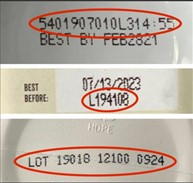How are Lot Codes used?

Lot codes and expiration dates are an integral part of the packaging process, but what do they mean and where are they used? Domino offers this brief overview, whether you are new to the manufacturing process or a seasoned pro, it's always a worthwhile refresher.
Simply put, a lot code helps identify one batch from another in a production environment. A more detailed definition would be that a lot number is a unique code that manufacturers assign to a batch of goods they’ve produced in the same run using the same ingredients, parts, or materials. They are crucial in industries such as food and pharmaceuticals, where they required by governing bodies like the FDA.
A primary purpose of a lot code is to help us as consumers identify whether the bag of lettuce in our refrigerator is part of the latest product recall. This product recall could be due to potential contamination due to a breach of the primary packaging. It could also be from cross contamination during the manufacturing process, potentially exposing the consumer to known allergens. Something might have gone wrong during the processing and packaging process, allowing metal to contaminate the product. Regardless of the reason why behind a product recall, this lot code will be key in communicating to consumers which batch of product is associated with the potential hazard.
Lot Control
These lot codes can also be part of a manufacturers internal process called lot control. Lot control is the process of managing your batches of products. It enables you to organize and understand what issues they might have. For example, if you need to recall a batch of goods or redistribute them. This lot control process provides additional insight such as:
- Stay organized by making it easier to differentiate similar products with slight variations, like a sodium free version of the same chicken broth.
- Identify issues quickly and troubleshoot where the problem came in.
- Reveal trends like which batch of products are selling the most, and whether there’s any correlation between the suppliers you’ve used and your most profitable items.
- Prevent counterfeit products by identifying where they are entering your supply chain so that you can take action to prevent more from coming in.
Lot codes are a necessary part of the supply chain. They provide an efficient method to trace product batches throughout the distribution cycle in addition to the benefits at the company level as mentioned above.
What's the difference between Expiration, Best By & Sell-By Dates?

When purchasing packaged foods, most of us look for some type of expiration date, sell-by date, or use-by date printed on the primary packaging to determine the freshness. It might be surprising that except for infant formula and baby food at the federal level and dairy products and meats in certain states, manufactures are under no legal obligation to provide a best-by or expiration date. The truth is that most food and beverage products do have some sort of code to tell you when it’s best to consume the product by, so let’s dig into how that date is communicated.
Best By Date
A best if used by/before date is a way of letting you know that for the best quality, freshness, texture and flavor, the product should be used by this date. It is not a purchase-by or safety date. Beyond this date, the product begins to deteriorate, although it may still be edible. The Grocery Manufacturers Association and the Food Marketing Institute also favor these terms rather than "expires on" or "sell by."
Expiration Date
A true expiration date is often present on items like lunch meat, cheese and milk and provides a date at which the product will truly begin to spoil and should not be used. For other types of food/beverage products, the manufacturer may have chosen to word it as expires by knowing that a certain product will lose its flavor or become stale past that date.
Sell-By
Two other terms you might see are a sell-by date, which would indicate when a supermarket should sell a product by, though it may remain safe to eat past that date, provided it’s properly refrigerated. The other term is guaranteed fresh date. This is a date used primarily on baked goods, letting you know that while it may be eaten past this date, the freshness or original quality of the food may be in jeopardy.
In Summary
Regardless of the lot code, expiration date, sell by date or guaranteed fresh date that is needed or desired, Domino has a full range of coding and marking equipment to print on almost any type of package or substrate. We can work with you and provide a cost-effective solution that will meet your needs and provide a reliable and easy to use printer that will last.
Reach out to your local Account Manager to discuss lot codes, expiration dates and how we can help you meet your requirements.